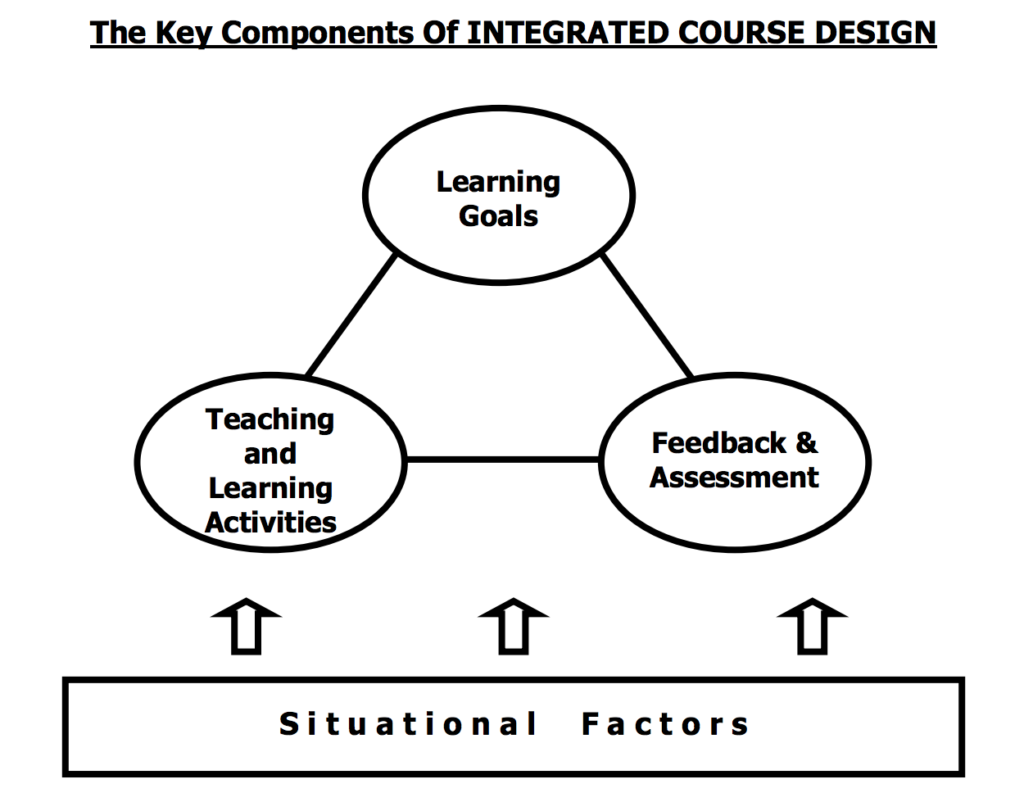Converting Beliefs and Theories into Course Design
In the last post we discussed how learning theories applied to what I believe about learning. This investigation has been fascinating to take a deeper dive into my beliefs. It has deepened my feelings about active learning. Recently I watched this video from Dr. Dwayne Harapnuik that discusses the difference between collecting and connecting dots. I found it a great analogy for many of the things I have been exploring. So much of traditional school is collecting dots and we do not spend the time to connect them. Then I read this article about how Professor Bharat Anand at the Harvard Business School is swapping content for connections. Essentially he is putting the emphasis on designing his course around connections instead of content.
So I thought….hey it’s great to have beliefs and understand established theories behind it; however, if we don’t design our courses with these things in mind what good does it do for our learners. Often we come to conclusions along the way and use our pedagogical tools to adapt once a course starts (always good to be flexible). However, how many times do we step back and design the course with this in mind from the get go?
So I turned to the work of L. Dee Fink to see what he thought about “Designing Courses for Significant Learning” and how it could apply to our Entrepreneurial Track. He believes that we should strive for an integrated course design that begins by analyzing what he calls the situational factors.
So I figured I would start to create the initial entrepreneurial course we have been discussing previously. Fick asks several questions to probe the situational factors in your course.
Specific Context of the Teaching/Learning Situation
This centers around the environment of the class. Thinking about Anand’s push towards connecting, we want this class to be blended and inquiry based. We will bring in external entrepreneurs to guide the different topics and rely on problem based learning along with collaboration.
General Context of the Learning Situation
One of the beauties of this class is that is doesn’t have to ladder up to some standard. We are developing this class to give student’s understanding in building their own start-ups. The assessment at the end of this class will be whether they can design a business plan that they could get funded.
Nature of the Subject
This class will surround practical application and need convergent thinkers. There is no right answer so it will be necessary for our learners to debate and explore each of their individual business plans.
Characteristics of the Learners
Most of the learners entering this class will have no prior knowledge of the subject. This is exciting as they will be able to explore and learn a great deal throughout this process. We also hope to push them to accept that there is no one way to start a business and that every business is different.
Characteristics of the Teacher
We have already discussed the need for everyday teachers who believe in allowing learners to construct their own learning. These teachers need to embrace this theory and work with our mentors to ask great questions to our learners. This will inspire them to investigate, learn and ultimately ask their own great questions.
Ok. Now that we have defined our situational factors it is now necessary to take that knowledge and combine them with our beliefs to design the class. Fink believes we now “formulate the learning goals, design the feedback and assessment procedures, and select the teaching/learning activities. What is distinctive about this model is that these components have been put together in a way that reveals and emphasizes their inter-relatedness.” (Fink, 2013) I think of this theory as a three-legged stool. If even one of the legs is not stable the whole thing falls down.

(Fink, 2013)
Since we are talking about entrepreneurship, it might be nice to add the thoughts of Jim Collins and Built to Last. Let’s add a Big Hairy Audacious Goal for the course to help us construct our learning goals. So we have discussed this before in our review of 4DX and Influencer, we want learners to ask great questions.
BHAG (Big Hairy Audacious Goal) – Overarching Course Goal
Learners will …develop an entrepreneurial spirit that will allow them ask great questions instead of simply giving compliant answers.
Fink then lays out a 3 column table to help us design our course. It focuses the three legs of our hypothetical stool and how they integrate together.
| Learning Goals | Learning Activities | Assessment Activities |
| Foundational
Learners will research and analyze the different types of business models then compare and contrast each. |
The class will break into groups each with a different learning model. They will present their model and try to persuade their classmates it is the best model. | Presentation
Blog reflection |
| Application
Learners will investigate and develop plans for different skills/aspects (i.e. finance, sales, inventory etc.) of a fictional business. |
Mentors will present problems based on an aspect/skill of business. For example mentor will ask learners to determine how to source and store the material necessary for their fictional business. | Presentation of their project
Annotated list of resources used and why Blog reflection |
| Integration
Learners will develop their own business plan for a start-up they would like to have funded. |
Learners will write a formal business plan with help from one of the mentors. They will then work on a presentation to be given to a panel of mentor “investors.” | Written business plan
“Shark Tank” presentation of their business for funding Blog reflection |
| Human Dimension and Caring
Learners will investigate and examine how human resources are addressed in a business setting. |
Learners will research and analyze different aspects of human resources in business along with their mentors. Learners will then role play different human resource issues and opportunities. | Analysis of role playing issues through Google Form
Blog reflection |
| Learning How To Learn
Learners will reflect upon the experience of their mentors and the questions that needed to be asked and answered in order to form their business. |
Students will create and maintain their own e-Portfolio throughout the course. | Learners will reflect on their individual blogs weekly. |
While it is great to understand your beliefs and the theories that back them up, it is even more important to put them into action. As you can see Fink is one way to help you do that. Another well known resource is Grant Wiggins Understanding by Design which I’ll investigate in our next post.
Resources
Collins, J. C., & Porras, J. (1994). Built to last: successful habits of visionary companies. New York, NY: HarperBusiness.
Connecting the Dots vs Collecting the Dots [Video file]. (2015, August 15). In YouTube. Retrieved December 4, 2016, from https://www.youtube.com/watch?v=85XpexQy68g
Fink, L. D. (2013). Creating significant learning experiences: An integrated approach to designing college courses. Hoboken, NJ: John Wiley & Sons.
Gordon, A. (2016, December 4). Harvard professor swaps content For connections in edtech strategy u-turn. Retrieved from http://www.forbes.com/sites/adamgordon/2016/12/04/harvard-hbx-edtech-digital-strategy/#4daeb7b81b4c


